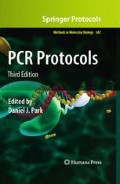Abstract
Asynchronous PCR (aPCR) is a new PCR method that directs an ordered and sequential amplification of the + and − strands of DNA amplicons. There are several unique characteristics of aPCR that generate new application opportunities. The melting temperature (Tm) of the forward and reverse aPCR primers differ by at least 15°C. The concentration of the lower Tm primer is reduced from 900 to 100 nM, thereby allowing for asynchronous or asymmetric strand-specific amplification. Furthermore, unique thermocycling parameter strategy dictates the + and − strand amplification cue. Each aPCR cycle includes two annealing and extension steps. Sequential annealing and extension of forward and reverse primers during each cycle produce transient single-stranded DNA (ssDNA) amplicons which help hybridization-based probes such as peptide nucleic acid (PNA) bind to the target sequences more effectively. This new method can be used in real-time quantitative PCR (qPCR) for gene expression analyses as well as production of robust ssDNA targets for microarray and other hybridization-based applications.
Access this chapter
Tax calculation will be finalised at checkout
Purchases are for personal use only
References
Holland, P. M., Abramson, R. D., Watson, R., and Gelfand, D. H. (1991) Detection of specific polymerase chain reaction product by utilizing the 5’–3’ exonuclease activity of Thermus aquaticus DNA polymerase, Proc Natl Acad Sci U S A 88, 7276–80.
Higuchi, R., Dollinger, G., Walsh, P. S., and Griffith, R. (1992) Simultaneous amplification and detection of specific DNA sequences, Biotechnology (N Y) 10, 413–7.
Wittwer, C. T., Herrmann, M. G., Moss, A. A., and Rasmussen, R. P. (1997) Continuous fluorescence monitoring of rapid cycle DNA amplification, Biotechniques 22, 130–8.
Whitcombe, D., Theaker, J., Guy, S. P., Brown, T., and Little, S. (1999) Detection of PCR products using self-probing amplicons and fluorescence, Nat Biotechnol 17, 804–7.
Nazarenko, I., Lowe, B., Darfler, M., Ikonomi, P., Schuster, D., and Rashtchian, A. (2002) Multiplex quantitative PCR using self-quenched primers labeled with a single fluorophore, Nucleic Acids Res 30, e37.
Nazarenko, I. A., Bhatnagar, S. K., and Hohman, R. J. (1997) A closed tube format for amplification and detection of DNA based on energy transfer, Nucleic Acids Res 25, 2516–21.
Gibson, U. E., Heid, C. A., and Williams, P. M. (1996) A novel method for real time quantitative RT-PCR, Genome Res 6, 995–1001.
Kutyavin, I. V., Afonina, I. A., Mills, A., Gorn, V. V., Lukhtanov, E. A., Belousov, E. S., Singer, M. J., Walburger, D. K., Lokhov, S. G., Gall, A. A., Dempcy, R., Reed, M. W., Meyer, R. B., and Hedgpeth, J. (2000) 3’-minor groove binder-DNA probes increase sequence specificity at PCR extension temperatures, Nucleic Acids Res 28, 655–61.
Livak, K. J., Flood, S. J., Marmaro, J., Giusti, W., and Deetz, K. (1995) Oligonucleotides with fluorescent dyes at opposite ends provide a quenched probe system useful for detecting PCR product and nucleic acid hybridization, PCR Methods Appl 4, 357–62.
Fiandaca, M. J., Hyldig-Nielsen, J. J., Gildea, B. D., and Coull, J. M. (2001) Self-reporting PNA/DNA primers for PCR analysis, Genome Res 11, 609–13.
Lee, L. G., Connell, C. R., and Bloch, W. (1993) Allelic discrimination by nick-translation PCR with fluorogenic probes, Nucleic Acids Res 21, 3761–6.
Egholm, M., Buchardt, O., Christensen, L., Behrens, C., Freier, S. M., Driver, D. A., Berg, R. H., Kim, S. K., Norden, B., and Nielsen, P. E. (1993) PNA hybridizes to complementary oligonucleotides obeying the Watson-Crick hydrogen-bonding rules, Nature 365, 566–8.
Svanvik, N., Nygren, J., Westman, G., and Kubista, M. (2001) Free-probe fluorescence of light-up probes, J Am Chem Soc 123, 803–9.
Wolffs, P., Knutsson, R., Sjoback, R., and Radstrom, P. (2001) PNA-based light-up probes for real-time detection of sequence-specific PCR products, Biotechniques 31, 766–71.
Tyagi, S. and Kramer, F. R. (1996) Molecular beacons: probes that fluoresce upon hybridization, Nat Biotechnol 14, 303–8.
French, D. J., Archard, C. L., Brown, T., and McDowell, D. G. (2001) HyBeacon probes: a new tool for DNA sequence detection and allele discrimination, Mol Cell Probes 15, 363–74.
Afonina, I. A., Reed, M. W., Lusby, E., Shishkina, I. G., and Belousov, Y. S. (2002) Minor groove binder-conjugated DNA probes for quantitative DNA detection by hybridization-triggered fluorescence, Biotechniques 32, 940–9.
Gyllensten, U. B. and Erlich, H. A. (1988) Generation of single-stranded DNA by the polymerase chain reaction and its application to direct sequencing of the HLA-DQA locus, Proc Natl Acad Sci U S A 85, 7652–6.
Author information
Authors and Affiliations
Editor information
Editors and Affiliations
Rights and permissions
Copyright information
© 2011 Humana Press
About this protocol
Cite this protocol
Chen, C., Ruff, D., Halsey, J. (2011). Asynchronous PCR. In: Park, D. (eds) PCR Protocols. Methods in Molecular Biology, vol 687. Humana Press. https://doi.org/10.1007/978-1-60761-944-4_16
Download citation
DOI: https://doi.org/10.1007/978-1-60761-944-4_16
Published:
Publisher Name: Humana Press
Print ISBN: 978-1-60761-943-7
Online ISBN: 978-1-60761-944-4
eBook Packages: Springer Protocols

